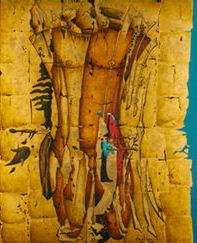Archived
Alexis Preller's Gold Kouros Shines at Strauss & Co
7 Jan 2011
Strauss & Co, Cape Town: On 7 March 2011 a fine example of a Gold Kouros by Alexis Preller from the Collection of Coba and Hennie Diedericks will be offered for sale at auction along with a selection of highly important works by celebrated South African artists including Irma Stern and Maggie Laubser

Alexis Preller Gold Kouros
Alexis Preller (South African 1911-1975)
Gold Kouros
Signed and dated ‘69
Oil and gold leaf on panel
61 by 51cm
R1 800 000 – 2 200 000
Provenance: Coba Diederiks. Acquired directly from the artist by Hennie Diederiks.
Gold Kouros is infused with Alexis Preller’s love of Greek culture and of the perfect male form. Not only did he meet Guna Massyn, the attractive youth who was to become his life’s companion but in 1968 he also undertook a trip to Greece. Thrilled to be exploring the ancient Aegean history, culture and mythology that had so fascinated him, Preller toured many sites including Delphi, the seat of Apollo and the famed oracle. As the son of Zeus, Apollo has been variously recognised as a god of light and the sun; truth and prophecy; medicine and healing. Being supportive of all the arts and the very epitome of civilization, Apollo is seen to be both creative and handsome.
Apollo’s youthfulness is captured in the sculpted figure of the kouros, which has come to represent the ideal of male beauty. Widespread across the archaic Greek world, they were generally carved from marble. As the ravages of time have taken their toll on many of these ancient sculptures, so limbs and even heads have been chipped away and lost.
Yet it is this very pared-down torso that so appealed to the artist – its absence of identifying features lending a universal appeal and anonymity that adds potency to Preller’s abstract theme. As Karel Nel has pointed out in his authoritative monograph co-authored with Esmé Berman, this is no individual but a powerful conception of manhood. “One fails to be concerned about the incompleteness of the figure: the mental image of this form is of a total being”.
In 1968 Preller wrote:
Greece was fine and good and healing for me and I loved being there. … In Athens I went often to the Museum, concentrating on about five things, and finally on the last day stayed long with the 6th century kouros from Megara.
Inspired by these figures and what they may represent, Preller sought ways of developing this new theme in his paintings. He began experimenting with gestural abstraction that minimises contour lines and creates the curious palpitating effect of both integrating the figure into the ground and projecting it forward. The iconic status of this symbol of beauty was further enhanced through the addition of gold leaf which pulsates against the Aegean turquoise at the right. The painting thus becomes a dynamic evocation of those timeless and static archaic figures.
According to Coba Diederiks, Preller’s use of gold leaf was inspired by the brass shields which he had seen in the Museum of Marathon. When a force of just 1 000 Athenian warriors routed a 24 000-strong Persian army at the Battle of Marathon in 490BC through a pre-dawn surprise attack, Pheidippides was dispatched to carry the news of victory to Athens. Today’s marathons commemorate that historic run.
Coba Diederiks (née Van Heerden) first met Alexis Preller when she was appointed to direct and organise exhibitions at the South African Association of Arts Gallery located in the Norman Eaton-designed Polley’s Arcade in Pretoria. Her academic qualifications and temperament perfectly complemented Preller’s innovative and meticulous approach to the presentation of his work, laying the foundations for an ongoing professional partnership and enduring friendship.
Coba explains that her husband Hennie Diederiks taught Alexis how to achieve the intaglio surfaces of his works by casting his three dimensional clay reliefs in fibreglass. This Gold Kouros was subsequently acquired in part payment for imparting these technical skills.
Text by Emma Bedford
Press Enquiries: Bina Genovese
2011 Press Releases
December
- 1 Dec 2011 Art and Glass Sparkle at Strauss & Co's Cape Town Auction in February
- 1 Dec 2011 Chairman's Report 2011
November
October
- 14 Oct 2011 Will tallest Sithole break new auction records?
- 15 Oct 2011 Gerard Sekoto at the Pinnacle of his Career
September
August
- 23 Aug 2011 Stunning Stern leads the field at Strauss & Co's Cape Town auction in September
- 29 Aug 2011 Stunning Stern comes to the market
July
- 5 Jul 2011 ALUMNI AND STAFF EXHIBITION and AUCTION & Michaelis School of Fine Art, University of Cape Town
- 21 Jul 2011 Over R718 000 raised for art bursaries at Michaelis
May
- 10 May 2011 Lost painting by Stern recalls one of South Africa's greatest musicians
- 20 May 2011 Greater Strength and Variety in the Art Market
April
- 1 Apr 2011 Flower name raises over half a million
- 13 Apr 2011 Pieter Wenning, an underrated artist
- 14 Apr 2011 Good Value in Quality Art at Strauss & Co
March
- 8 Mar 2011 An expensive cup of coffee
- 16 Mar 2011 Art beats JSE Index
February
- 3 Feb 2011 Two Early Cape Paintings
January
